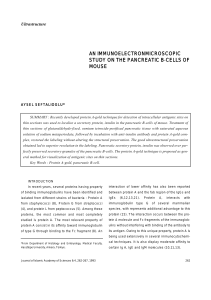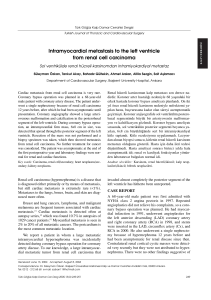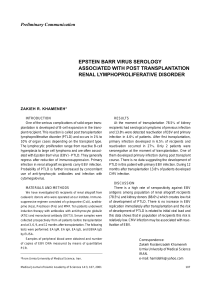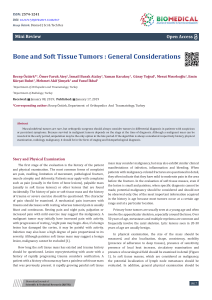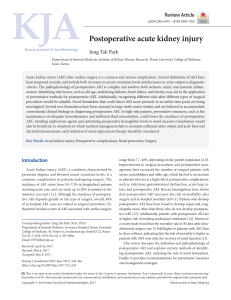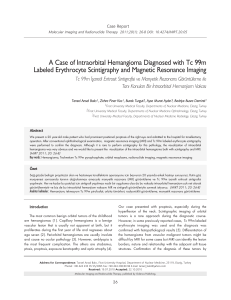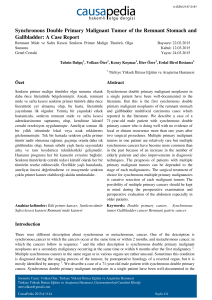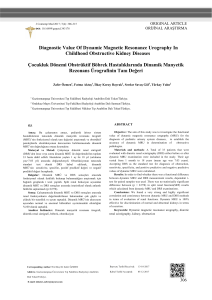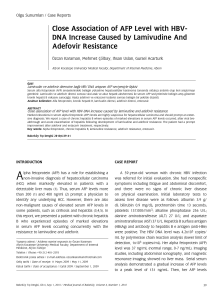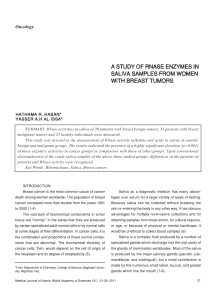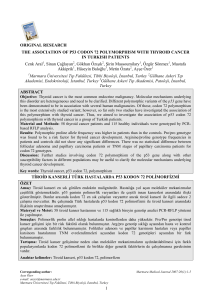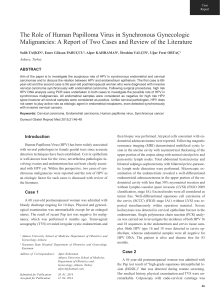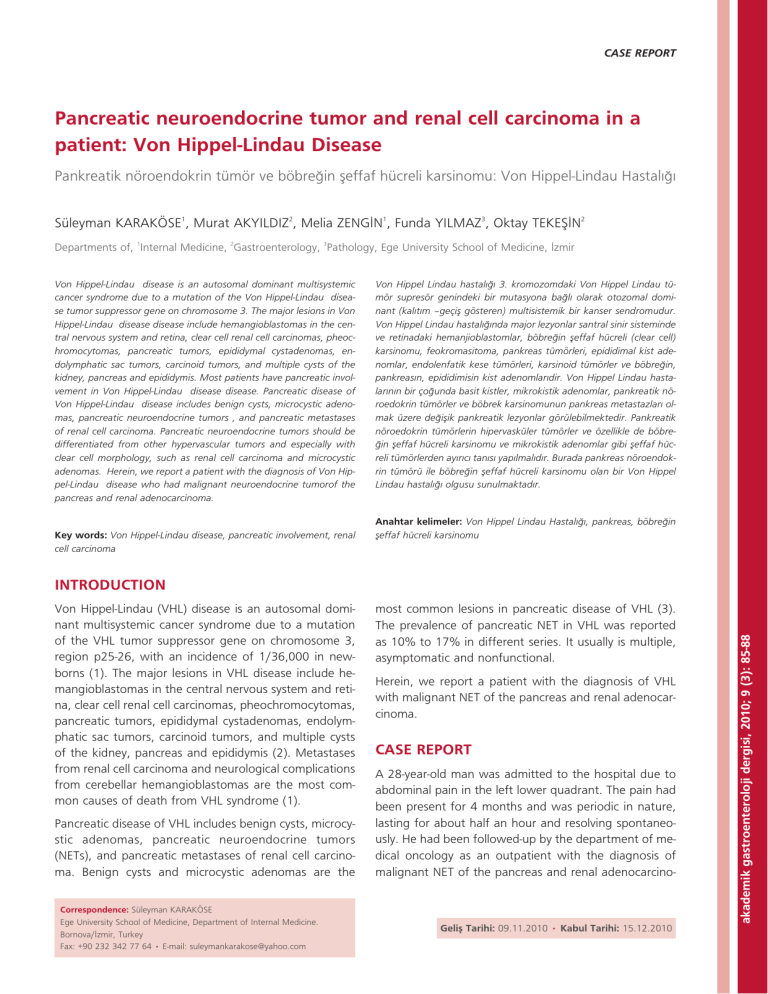
CASE REPORT
Pancreatic neuroendocrine tumor and renal cell carcinoma in a
patient: Von Hippel-Lindau Disease
Pankreatik nöroendokrin tümör ve böbre¤in fleffaf hücreli karsinomu: Von Hippel-Lindau Hastal›¤›
Süleyman KARAKÖSE1, Murat AKYILDIZ2, Melia ZENG‹N1, Funda YILMAZ3, Oktay TEKEfi‹N2
Departments of, 1Internal Medicine, 2Gastroenterology, 3Pathology, Ege University School of Medicine, ‹zmir
Von Hippel-Lindau disease is an autosomal dominant multisystemic
cancer syndrome due to a mutation of the Von Hippel-Lindau disease tumor suppressor gene on chromosome 3. The major lesions in Von
Hippel-Lindau disease disease include hemangioblastomas in the central nervous system and retina, clear cell renal cell carcinomas, pheochromocytomas, pancreatic tumors, epididymal cystadenomas, endolymphatic sac tumors, carcinoid tumors, and multiple cysts of the
kidney, pancreas and epididymis. Most patients have pancreatic involvement in Von Hippel-Lindau disease disease. Pancreatic disease of
Von Hippel-Lindau disease includes benign cysts, microcystic adenomas, pancreatic neuroendocrine tumors , and pancreatic metastases
of renal cell carcinoma. Pancreatic neuroendocrine tumors should be
differentiated from other hypervascular tumors and especially with
clear cell morphology, such as renal cell carcinoma and microcystic
adenomas. Herein, we report a patient with the diagnosis of Von Hippel-Lindau disease who had malignant neuroendocrine tumorof the
pancreas and renal adenocarcinoma.
Key words: Von Hippel-Lindau disease, pancreatic involvement, renal
cell carcinoma
Von Hippel Lindau hastal›¤› 3. kromozomdaki Von Hippel Lindau tümör supresör genindeki bir mutasyona ba¤l› olarak otozomal dominant (kal›t›m –geçifl gösteren) multisistemik bir kanser sendromudur.
Von Hippel Lindau hastal›¤›nda major lezyonlar santral sinir sisteminde
ve retinadaki hemanjioblastomlar, böbre¤in fleffaf hücreli (clear cell)
karsinomu, feokromasitoma, pankreas tümörleri, epididimal kist adenomlar, endolenfatik kese tümörleri, karsinoid tümörler ve böbre¤in,
pankreas›n, epididimisin kist adenomlar›dir. Von Hippel Lindau hastalar›n›n bir ço¤unda basit kistler, mikrokistik adenomlar, pankreatik nöroedokrin tümörler ve böbrek karsinomunun pankreas metastazlar› olmak üzere de¤iflik pankreatik lezyonlar görülebilmektedir. Pankreatik
nöroedokrin tümörlerin hipervasküler tümörler ve özellikle de böbre¤in fleffaf hücreli karsinomu ve mikrokistik adenomlar gibi fleffaf hücreli tümörlerden ay›r›c› tan›s› yap›lmal›d›r. Burada pankreas nöroendokrin tümörü ile böbre¤in fleffaf hücreli karsinomu olan bir Von Hippel
Lindau hastal›¤› olgusu sunulmaktad›r.
Anahtar kelimeler: Von Hippel Lindau Hastal›¤›, pankreas, böbre¤in
fleffaf hücreli karsinomu
Von Hippel-Lindau (VHL) disease is an autosomal dominant multisystemic cancer syndrome due to a mutation
of the VHL tumor suppressor gene on chromosome 3,
region p25-26, with an incidence of 1/36,000 in newborns (1). The major lesions in VHL disease include hemangioblastomas in the central nervous system and retina, clear cell renal cell carcinomas, pheochromocytomas,
pancreatic tumors, epididymal cystadenomas, endolymphatic sac tumors, carcinoid tumors, and multiple cysts
of the kidney, pancreas and epididymis (2). Metastases
from renal cell carcinoma and neurological complications
from cerebellar hemangioblastomas are the most common causes of death from VHL syndrome (1).
Pancreatic disease of VHL includes benign cysts, microcystic adenomas, pancreatic neuroendocrine tumors
(NETs), and pancreatic metastases of renal cell carcinoma. Benign cysts and microcystic adenomas are the
Correspondence: Süleyman KARAKÖSE
Ege University School of Medicine, Department of Internal Medicine.
Bornova/‹zmir, Turkey
Fax: +90 232 342 77 64 • E-mail: [email protected]
most common lesions in pancreatic disease of VHL (3).
The prevalence of pancreatic NET in VHL was reported
as 10% to 17% in different series. It usually is multiple,
asymptomatic and nonfunctional.
Herein, we report a patient with the diagnosis of VHL
with malignant NET of the pancreas and renal adenocarcinoma.
CASE REPORT
A 28-year-old man was admitted to the hospital due to
abdominal pain in the left lower quadrant. The pain had
been present for 4 months and was periodic in nature,
lasting for about half an hour and resolving spontaneously. He had been followed-up by the department of medical oncology as an outpatient with the diagnosis of
malignant NET of the pancreas and renal adenocarcino-
Gelifl Tarihi: 09.11.2010 • Kabul Tarihi: 15.12.2010
akademik gastroenteroloji dergisi, 2010; 9 (3): 85-88
INTRODUCTION
KARAKÖSE ve ark.
ma. His medical history revealed that he underwent
Whipple operation because of malignant NET of the pancreas six years ago and partial right nephrectomy due to
renal adenocarcinoma three years ago. Whipple operation was performed because of a 4 cm diameter mass
with solid and cystic components in the head of the pancreas. The histopathologic examination of the specimen
showed cells with clear cytoplasm and uniform nuclei without prominent atypia, which were organized as ribbons, cords or mostly trabeculae (Figure 1). The mitotic
index and Ki-67 index were 11% and 25%, respectively.
The tumor cells had positive staining with synaptophysin
but were negative for chromogranin–A, vimentin and
monoclonal carcinoembryonic antigen (Figure 2). Direct
tumor invasion in peripancreatic lymph nodes and peri-
neural and vascular invasion within the tumor mass were noted (Figures 3, 4). He became diabetic after pancreatectomy. He had glaucoma and his left eye was enucleated as a result. Physical examination revealed incision
scars on his abdomen and no abdominal tenderness or
rebound. He had a prosthetic left eye. There was no other specific feature on physical examination. Laboratory
parameters including hemogram, erythrocyte sedimentation rate and biochemical analysis were within normal limits. There was no pathologic finding on abdomen ultrasonography, upper gastrointestinal system endoscopy,
small intestine passage imaging, abdominopelvic spiral
computerized tomography (CT), and endosonographic
examination except for a fibrous mass under the incision
region. There was no new tumoral mass or metastatic lesion. Ophthalmology consultation was performed given
the presence of glaucoma and diabetes mellitus. Ophthalmologic examination showed retinal angiomatosis lesions. In addition, cranial magnetic resonance imaging
(MRI) detected a hemangioblastic lesion on the left side
of the bulbus, although cranial CT was normal. Those lesions were confirmed with cranial angio CT. The patient
was considered as type 1 VHL disease with the components of malignant pancreas NET, renal adenocarcinoma, and hemangiomas of the retina and central nervous
system. He has been followed as an outpatient by the
departments of medical oncology, neurology and neurosurgery for two months and is currently well.
DISCUSSION
Figure 1. Histologic section from the pancreatic mass showing cells
with clear cytoplasm and uniform nuclei without prominent atypia,
and which were organized as ribbons, cords or trabeculae (Hematoxylin-eosin, x100).
Figure 2. Immunohistochemical synaptophysin positivity (Hematoxylin-eosin, x100).
86
Von Hippel-Lindau (VHL) disease is characterized by the
presence of benign and malignant tumors and is associated with germ line mutation of the VHL gene of chromosome 3 (4). The diagnosis of VHL may be made in a patient with a family history of VHL based on a single retinal or cerebellar hemangioblastoma, renal cell carcinoma or pheochromocytoma, and possibly, multiple pancreatic cysts. In the absence of a family history of VHL,
the presence of two or more retinal or cerebellar hemangioblastomas or of one hemangioblastoma with one visceral tumor is required for diagnosis (5). VHL disease is
classified according to the presence of pheochromocytoma; VHL disease without and with pheochromocytoma
is classified as type 1 or type 2, respectively (2). The present case was considered as type 1 VHL disease, and we
could not perform genetic analysis.
Pancreatic involvement in VHL disease was reported as
being between 17% to 77% in various imaging series
(3,6,7,8). Different pancreatic lesions such as benign
cysts, cystadenomas, adenocarcinomas, hemangioblas-
Von Hippel Lindau Disease
Figure 3. Perineural invasion in the pancreatic tumor (DAB, x400).
Figure 4. Direct invasion of the pancreatic tumor to the peripancreatic lymph nodes (Hematoxylin–eosin, x200).
tomas, NET, and metastasis of renal cell carcinoma have
been reported. Pancreatic cysts are the most common lesion in the pancreatic involvement of VHL disease and
are usually multiple, and almost 40% of them had calcification (6,9,10). Multiple pancreatic cysts should call to
mind VHL disease as well as polycystic renal disease.
(8,14,15). Similarly, microcytic adenoma and metastatic
renal cell carcinoma may have clear cell morphology. Histopathological and immunohistochemical features are
the main factors for differentiating those tumors (11).
Clear cell renal carcinomas usually have thin fibrovascular septae, and pancreatic microcystic adenomas are usually glycogen–rich; both of them show negative immunostaining for neuroendocrine markers (11). On the other hand, pancreatic NETs have broad collagen bands
and are not glycogen-rich and show positive immunostaining for neuroendocrine markers. In the present case,
pathologic examination of the pancreatic lesion showed
clear cell tumor cells that were organized as ribbons,
cords or mostly trabeculae with collagen bands, and tumor cells showed positive staining with synaptophysin.
The prevalence of pancreatic NET has been reported as
between 10% to 17% in different series (3,8). Pancreatic NET in VHL disease is usually nonfunctional (11). Pancreatic NET in VHL disease should be differentiated from
other hypervascular tumors such as hemangioblastomas,
vascularized microcystic (serous) adenomas and metastasis of renal cell carcinoma. Pancreatic hemangioblastomas can be seen rarely in VHL disease and immunohistochemistry analysis is also helpful in the differential diagnosis (12). Microcystic adenomas and renal cell carcinoma metastasis are the most common lesions that should be remembered in the differential diagnosis of pancreatic NET (3). Renal cell carcinoma is one of the most
common tumors in VHL disease and can metastasize to
the pancreas (13,14). Clear cell morphology is known as
a distinguishing pathological feature of pancreatic NET
In conclusion, most patients with VHL disease have pancreatic involvement. Pancreatic NETs in VHL disease are
usually multiple and have malignancy potential. They
should be differentiated from other vascular tumors
and especially from metastasis of renal cell carcinoma
since the therapeutic decision and management are not
easy.
REFERENCES
1. Joerger M, Koeberle D, Neumann HP, Gillessen S. Von Hippel-Lindau disease--a rare disease important to recognize. Onkologie
2005; 28: 159-63.
5. Friedrich CA. Von Hippel-Lindau syndrome. A pleomorphic condition. Cancer 1999; 86: 2478-82.
2. Sano T, Horiguchi H. Von Hippel-Lindau disease. Microsc Res Tech
2003; 60: 159-64.
6. Hough DM, Stephens DH, Johnson CD, Binkovitz LA. Pancreatic lesions in Von Hippel-Lindau disease: prevalence, clinical significance, and CT findings. Am J Roentgenol 1994; 162: 1091-4.
3. Hammel PR, Vilgrain V, Terris B, et al. Pancreatic involvement in
Von Hippel-Lindau disease. Gastroenterology 2000; 119: 1087-95.
7. Mukhopadhyay B, Sahdev A, Monson JP, et al. Pancreatic lesions
in Von Hippel-Lindau disease. Clin Endocrinol 2002; 57: 603-8.
4. Marcos HB, Libutti SK, Alexander HR, et al. Neuroendocrine tumors of the pancreas in Von Hippel-Lindau disease: spectrum of
appearances at CT and MR imaging with histopathologic comparison. Radiology 2002; 225: 751-8.
8. Osawa A, Sumiyama Y, Watanabe M, et al. Single case of renal
cell carcinoma and endocrine pancreatic head cancer occurring
with Von Hippel-Lindau disease. J Hepatobiliary Pancreat Surg
2006; 13: 174-80.
87
KARAKÖSE ve ark.
9. Seizinger BR, Rouleau GA, Ozelius LJ, et al. Von Hippel-Lindau disease maps to the region of chromosome 3 associated with renal
cell carcinoma. Nature 1988; 332: 268-9.
10. Neumann HP, Dinkel E, Brambs H, et al. Pancreatic lesions in the
Von Hippel-Lindau syndrome. Gastroenterology 1991;101: 465-71.
11. Lubensky IA, Pack S, Ault D, et al. Multiple neuroendocrine tumors
of the pancreas in Von Hippel-Lindau disease patients: histopathological and molecular genetic analysis. Am J Pathol 1998; 153:
223-31.
12. Fill WL, Lamiell JM, Polk NO. The radiographic manifestations of
Von Hippel-Lindau disease. Radiology 1979; 133: 289-95.
88
13. Neumann HP, Bender BU, Berger DP, et al. Prevalence, morphology and biology of renal cell carcinoma in Von Hippel-Lindau disease compared to sporadic renal cell carcinoma. J Urol 1998; 160:
1248-54.
14. Hoang MP, Hruban RH, Albores-Saavedra J. Clear cell endocrine
pancreatic tumor mimicking renal cell carcinoma: a distinctive neoplasm of Von Hippel-Lindau disease. Am J Surg Pathol 2001; 25:
602-9.
15. Musso C, Paraf F, Petit B, Archambeaud-Mouveroux F, Valleix D,
Labrousse F. Pancreatic neuroendocrine tumors and Von HippelLindau disease. Ann Pathol 2000; 20: 130-3.

